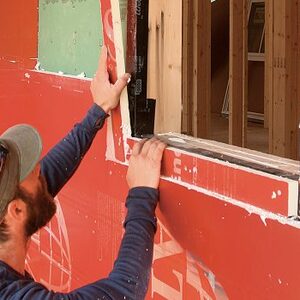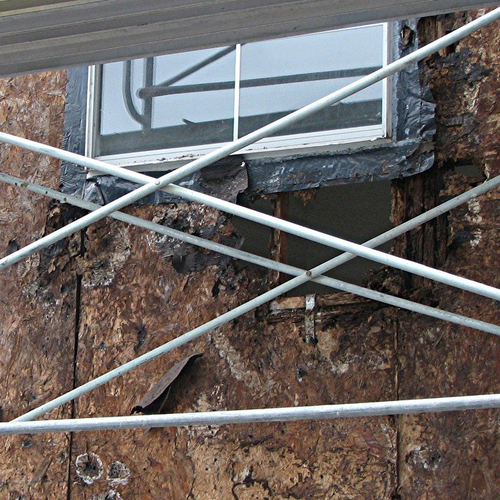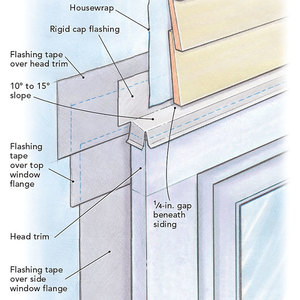
Roofers have a distinct way of looking at buildings. Scanning a building from the street, a roofer’s eyes usually start at the ridge and follow an imaginary raindrop all the way to the ground. Some roofers even watch the imaginary raindrop bounce, to determine whether it will lead to splashback problems.
Roof leaks are less likely when the raindrop travels quickly than when it travels slowly. What slows a raindrop on its trip from the ridge to the eaves? Several possible impediments: moss, for example, or a collection of autumn leaves, or snow, or ice, or a narrow roof valley. If the roof has a very shallow pitch, there are other possible impediments to a raindrop’s speedy voyage: frisbees, perhaps, or tennis balls.
Most architects lack a roofer’s eye. While a roofer delights in the sight of a simple uninterrupted gable roof, architects entertain flights of fancy: they come up with butterfly roofs, or flat roofs surrounded by parapets and scuppers, or complicated roofs interrupted by multiple valleys and dormers.
The roofer’s ideal
From a roofer’s perspective, the ideal roof is a simple gable roof or saltbox without any valleys, chimneys, dormers, or skylights. The pitch is fairly steep—say, between 4-in-12 and 12-in-12. (A steep pitch reduces the chance that frisbees, tennis balls, and leaves will accumulate on the roof, and a steep pitch speeds up a raindrop’s descent. Steep-pitched roofs are always more forgiving of minor leaks than shallow-pitched roofs.) The ideal roof has wide overhangs on all four sides—at the eaves as well as the rakes. Some roofers like to see gutters at the eaves; others—especially those who live in cold, snowy climates—disdain gutters, since gutters often contribute to ice dams.
A raindrop that lands near the ridge…
Weekly Newsletter
Get building science and energy efficiency advice, plus special offers, in your inbox.

This article is only available to GBA Prime Members
Sign up for a free trial and get instant access to this article as well as GBA’s complete library of premium articles and construction details.
Start Free TrialAlready a member? Log in















15 Comments
Humm… Are you OK? Is retirement stressful? ;-)) I do happen to agree with most of it, but since most designers and clients are not roofers... they continue to do as they want and or like.
For the last few years, many modern houses have been designed with monopitch, or shed, roof going off to all directions. I have designed a few of those houses that want “to fly away during the next tornado”, and even though I was not a fan at first, those roofs have grown on me, in grand part because, a) beauty is in the eye of the beholder, b) architectural styles change with time, zip code, climate zones, regions, etc., and c) the customer loves it, and that is numero uno in my book, like it or not.
Thank goodness the Mediterranean style of homes, for the most part, is over in our area. I never knew if Mediterranean meant Tuscany, Morocco, Lebanon or Santorini, could you? Before was the Old World… Old World what? French? English? Chinese? Pyramids? Enough to get a headache!
My entirely anecdotal observation is that roofers have a higher incidence of alcohol related issues than the general public. Many attribute this to their ex-wives, but I think it's more closely related to what Martin writes about in this blog. They arrive on site and are asked to somehow make the wildly inappropriate roofs they find waterproof.
Here in the PNW one current architectural fashion is for houses to have a series of reverse shed-dormers all of which drain onto a small flat roof area in the middle of the structure. Some of them even manage not to leak initially, saving that treat for the homeowners to enjoy in the future.
I enjoyed all the accompanying photos, but one really puzzled me: How have they managed to side one of the three small dormers before roofing?
Do you mean the "Butterfly" style roof? We got'em too... I haven't had the nerve to design one, YET!
Armando,
More like these from a town just down the road from me:
Darn it... I realized I lied. Here is my contribution! 🤠
Armando,
Those look pretty straightforward. I'm confident I could build them so they worked and lasted fine.
While this roof may funnel water into the interior and have no overhangs despite having a reservoir cladding in a humid, cooling climate; it is really neat looking.
The architect missed an opportunity to add small chimneys in each of the valleys, however. Oh well, next time.
Rick,
Yeah. Dead-valleys work until they don't.
I did just design a mono-pitch roof with zero penetrations. I was able to get the plumbing vent out a high gable. Roofer was happy.
Having worked at a roofing company even just briefly - dead valleys and complex roof designs stick out like very expensive sore thumbs to me now. This article speaks to me!
Also we can get a fair bit of snow in Nova Scotia. I see all these fancy Instagram worthy pictures of homes with metal roofs with no overhangs and cringe. And windows practically to the ground where your smooth no overhang roof is going to dump a big pile of snow up against your cladding and windows. Or worse, no overhang and no gutters. Where does the water go people!? Ack! Pretty... maybe. Practical - NO!
Better hope your waterproofing details are bang on. I'd love to see some of those a few years on. Cladding would look a disaster.
More complexity = more problems = more material and labour expense.
Many people are oblivious to the benefits of simplicity and good design.
Doug, you couldn't be more correct.
It's hard to tell, but this my deck with about 5 feet of snow that fell from our standing seam metal roof. We have 8' windows and sliders that go right to the deck. I had hoped the 2' overhangs would have been sufficient. No way.
I hope to finally add the snow guards before this winter.
Rick,
The good thing about deep snow that accumulates at the base of exterior walls is that rot can't occur in cold weather. The organisms that promote wood rot aren't active until the thermometer rises.
The rot danger doesn't actually begin until a thaw. So when the weather warms up, you need to be ready with your show shovel.
Good plan Rick! That's a lot of snow up against the windows.
We get a lot of partial melt and refreeze temps throughout our Nova Scotia winters so it can create a really thick ice at the bottom. And snow near the window melts and freezes too. Clearing the snow can be delicate work as it's so much weight pushing up against the window. I usually got out and cleaned up up before it hardened up.
I've been "enjoying" the task of VT snow removal from our place in Stowe. I never really thought about it before, but the snow pushes over the deck railings, too. This was almost 3' in one hit and it was only January. Can't wait to move there and do this all the time!
Peter,
I never think about snow when designing here on Southern Vancouver Island, but these photos of my place were taken last winter.
Log in or become a member to post a comment.
Sign up Log in